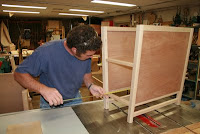

Some discussion about the design of the side piece. This client uses a lap top so ergonomic considerations for typing are important. After some discussion about desk top height; 29 1/2" is ideal for writing but can change for different size people, a pull out tray height; lap top and keyboard surface is ideal at 26"-28" form the floor, anticipated work habits; the client wants to be able to write, type and layout reference materials at the same time. We did not want to compromise the desk height and proportions, and adding a keyboard tray seemed like a compromise so I redesigned the side piece to accommodate the lap top, on an angled surface, and the printer under in the open bank, and added length for ample leg room.

























